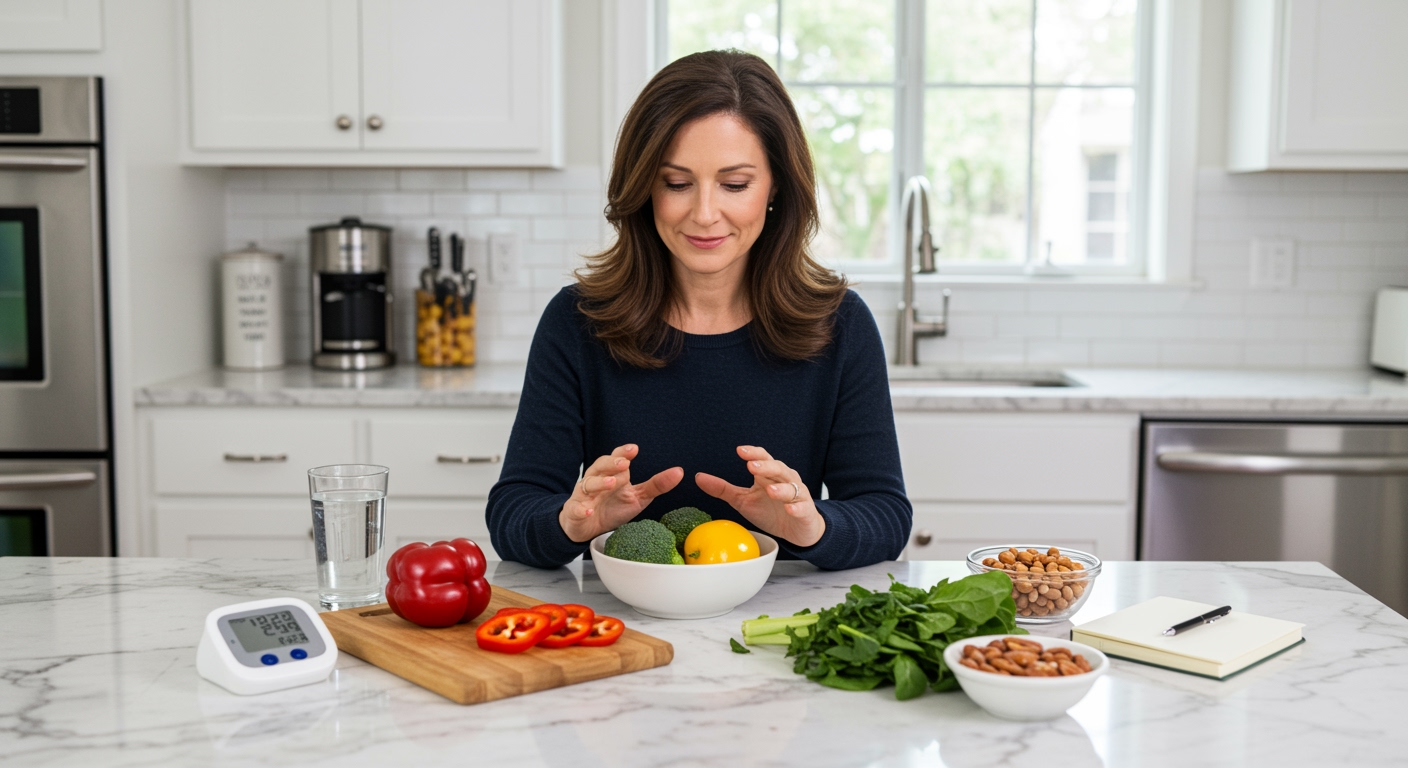✪ Key Takeaway: Mindful eating can lower blood pressure by reducing stress, improving food choices, and supporting weight management.
Introduction
Your blood pressure monitor shows those dreaded high numbers again, and you wonder if there is something beyond medication that can help.
You might be asking this question because traditional approaches feel limiting, or perhaps you want to explore natural methods that work alongside your current treatment plan.
Hi, I am Abdur, your nutrition coach, and today I am going to explain how mindful eating can become a powerful tool in your blood pressure management strategy.
What Exactly Is Mindful Eating?
Mindful eating means paying complete attention to your food and eating experience without distractions.
This practice involves noticing the colors, textures, flavors, and smells of your food while eating slowly and deliberately.
You focus on your body’s hunger and fullness signals rather than eating based on emotions, time, or external cues.
Research shows that mindful eating activates the parasympathetic nervous system, which promotes relaxation and better digestion.
This relaxation response directly counteracts the stress response that contributes to elevated blood pressure.
✪ Fact: Studies show mindful eating can reduce systolic blood pressure by 5-10 mmHg in just 8 weeks.
How Does Mindful Eating Impact Blood Pressure?
Mindful eating affects blood pressure through multiple biological pathways that work together to create lasting changes.
When you eat mindfully, your body produces less cortisol, the stress hormone that causes blood vessels to constrict and blood pressure to rise.
The practice also improves insulin sensitivity, which helps your body process glucose more efficiently and reduces inflammation in blood vessels.
Mindful eating naturally leads to better portion control, which supports healthy weight management – a crucial factor in blood pressure regulation.
The slower eating pace allows your brain to receive satiety signals properly, preventing overeating that can spike blood pressure temporarily.
Additionally, mindful eating often results in choosing more nutrient-dense foods that naturally support cardiovascular health.
✪ Pro Tip: Start with just one mindful meal per day to build this habit gradually and sustainably.
What Are The Best Mindful Eating Techniques?
The 5-4-3-2-1 technique helps you engage all your senses before eating: notice 5 things you see, 4 you can touch, 3 you hear, 2 you smell, and 1 you taste.
Chewing slowly is fundamental – aim for 20-30 chews per bite to allow proper digestion and give your brain time to register fullness.
Put your fork down between bites and take a moment to breathe, which activates the relaxation response that helps lower blood pressure.
Practice the hunger scale by rating your hunger from 1-10 before eating and stopping when you reach a comfortable 7.
Remove all distractions like phones, TV, or computers to focus entirely on your eating experience.
Start each meal with three deep breaths to center yourself and prepare your body for optimal digestion.
✪ Note: It takes about 20 minutes for your brain to register fullness, so eating slowly is crucial.
Can Mindful Eating Replace Blood Pressure Medication?
Mindful eating should never replace prescribed blood pressure medication without your doctor’s guidance and approval.
However, it can be a powerful complementary approach that may help reduce your medication needs over time when combined with other lifestyle changes.
Studies show that mindful eating, combined with regular exercise and stress management, can lead to significant improvements in blood pressure control.
Some people experience such dramatic improvements that their doctors are able to reduce medication dosages gradually under medical supervision.
The key is consistency – mindful eating must become a daily practice rather than an occasional effort to see lasting results.
Always work with your healthcare provider to monitor your progress and make any necessary adjustments to your treatment plan.
✪ Pro Tip: Keep a food and mood journal to track how mindful eating affects your blood pressure readings.
The Bottom Line
Mindful eating offers a scientifically-backed approach to supporting healthy blood pressure through stress reduction, better food choices, and improved weight management.
The fork in your hand is more powerful than you think – use it mindfully and watch your health transform.
I would love to hear about your experiences with mindful eating or any questions you might have about implementing these techniques in your daily routine – please share your thoughts in the comments below.
References
At NutritionCrown, we use quality and credible sources to ensure our content is accurate and trustworthy. Below are the sources referenced in creating this article:
- NIH Research Matters: Mindfulness training can boost heart-healthy eating
- Brown University: Mindfulness and Hypertension Research
- American Heart Association: Mindfulness shows promise as an effective intervention to lower blood pressure
- Western Health: Your fork is more powerful than you think: the philosophy and practice of mindful eating





